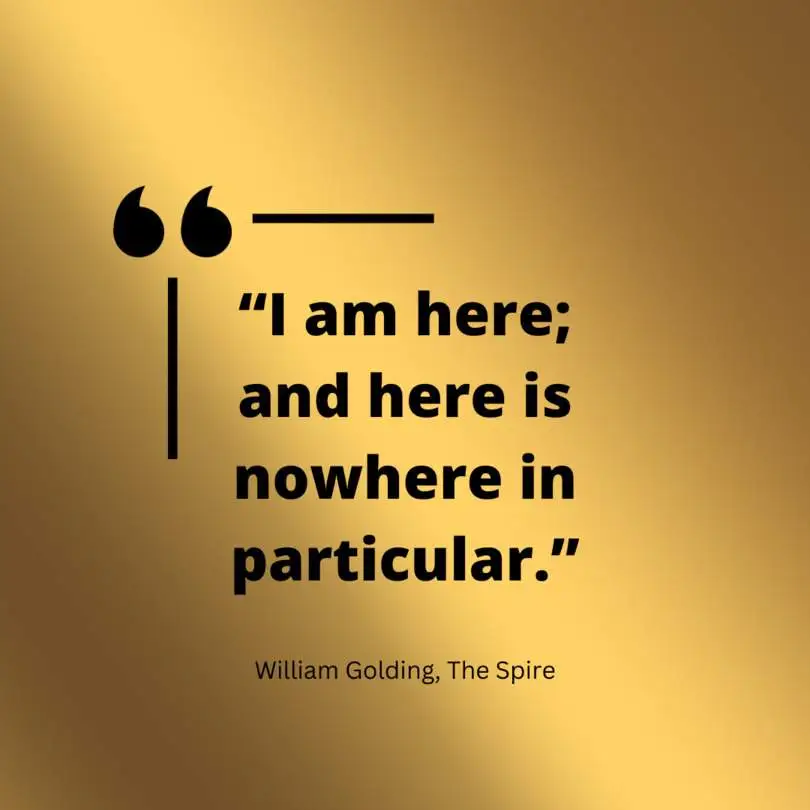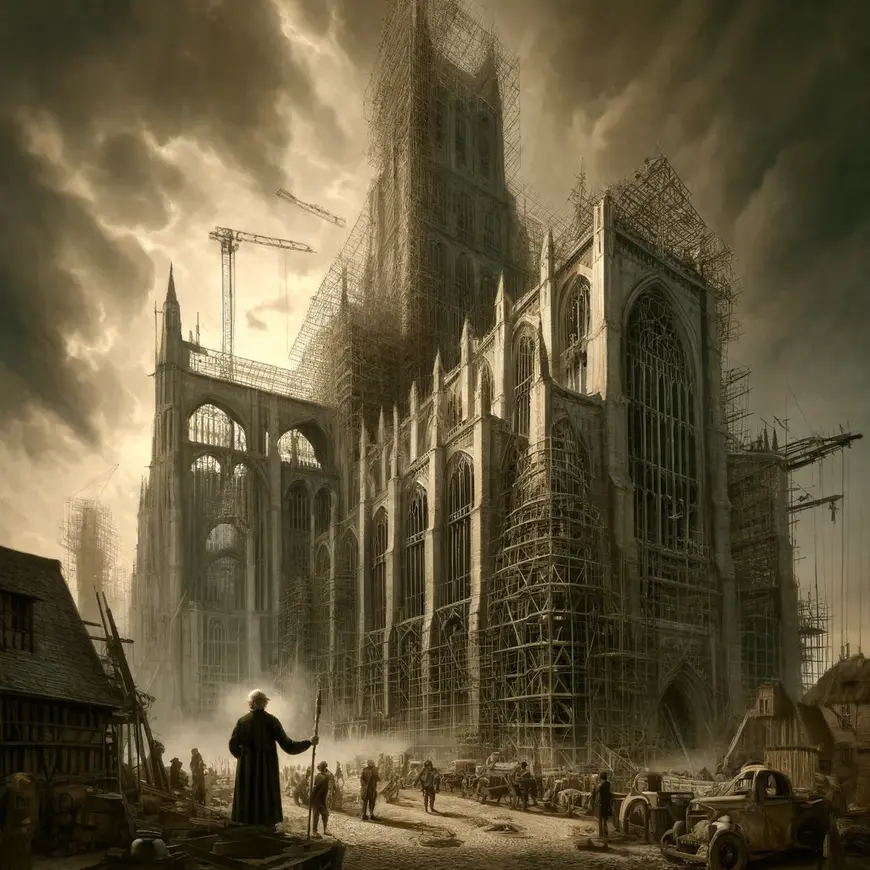William Golding’s Towering Tale of Ambition and Descent – Unraveling “The Spire”
William Golding, acclaimed for his classic “Lord of the Flies,” ventures into the realm of Gothic fiction with “The Spire.” This haunting tale unfolds within the confines of a medieval cathedral, exploring the psychological and spiritual unraveling of its ambitious dean, Jocelin. Golding’s prose, both evocative and disturbing, builds a narrative that probes the limits of human aspiration and the consequences of unchecked ambition.
Plot Overview: “The Spire”
Set in the fictional town of Kingsbridge during the 14th century, “The Spire” revolves around the ambitious endeavor to erect a massive spire atop the cathedral. Dean Jocelin, driven by a divine vision, is determined to transcend the limitations of earthly structures and build a spire that reaches toward the heavens.
As the construction begins, Jocelin’s vision becomes an obsession, blinding him to the physical, financial, and human costs of his ambitious project. The novel explores the psychological toll on Jocelin and those around him as the construction of the spire tests the limits of faith, morality, and sanity.

Characterization:
Central to “The Spire” is Dean Jocelin, a complex character whose descent into obsession becomes a microcosm of the broader exploration of human nature. Jocelin’s unwavering conviction in his divine calling, coupled with his disregard for the concerns of others, sets the stage for a tragic tale of spiritual and psychological unraveling.
The supporting cast, including the master builder Roger Mason, the enigmatic Rachel, and the skeptical subdean Pangall, adds depth to the narrative. Each character represents different facets of the human condition, contributing to the novel’s exploration of faith, doubt, and the consequences of unchecked ambition.
Themes: “The Spire”
“The Spire” delves into profound themes that resonate throughout the narrative. The novel explores the interplay between faith and madness, challenging the boundaries of religious fervor and the fragility of the human mind. Golding examines the impact of ambition on individuals and communities, portraying the spire as both a physical and metaphorical manifestation of human aspirations reaching toward the divine.
The theme of sexual desire and repression also weaves through the narrative, adding a layer of complexity to Jocelin’s character. Golding uses the spire as a symbol of Jocelin’s inner turmoil, exploring the tension between earthly desires and spiritual aspirations.
Gothic Atmosphere:
Golding masterfully crafts a Gothic atmosphere in “The Spire,” using the cathedral as a dark and foreboding backdrop. The crumbling stones, echoing halls, and labyrinthine passageways become integral to the narrative, mirroring the psychological labyrinth in which Jocelin finds himself trapped.
The author employs vivid and sometimes grotesque imagery to evoke a sense of unease and foreboding. The cathedral, once a symbol of divine worship, becomes a haunting presence, reflecting the unraveling sanity of its dean and the moral decay within its walls.
Language and Style:
Golding’s language in “The Spire” is both poetic and unsettling. His prose, while rich with descriptive detail, is not without its moments of disquieting simplicity. The author’s ability to evoke a sense of unease through language contributes to the Gothic ambiance, drawing readers into the psychological depths of the characters.
The novel’s fragmented narrative, marked by shifts in perspective and time, adds to the disorienting experience. Golding’s style invites readers to navigate the labyrinth of Jocelin’s mind, mirroring the protagonist’s descent into obsession.
Psychological Exploration:
At its core, “The Spire” is a psychological exploration of a man teetering on the brink of obsession and madness. Golding delves into Jocelin’s mind, unraveling the layers of his thoughts, fears, and desires. The spire becomes a metaphor for Jocelin’s unraveling psyche, a towering manifestation of his ambitions and internal conflicts.
Readers witness the gradual erosion of Jocelin’s sanity as his obsession with the spire intensifies. The novel becomes a journey into the darkest corners of the human mind, where faith and delusion entwine, and the pursuit of divine transcendence becomes a descent into madness.

Allegory and Symbolism:
“The Spire” is laden with allegorical elements and symbolism. The spire itself serves as a multifaceted symbol, representing both divine aspiration and the pitfalls of human ambition. Golding uses the physical structure as a canvas for exploring themes of transcendence, moral decay, and the consequences of relentless pursuit.
The crumbling stones of the cathedral, the mysterious figure of Rachel, and the recurring motif of ascent and descent all contribute to the novel’s allegorical depth. Golding invites readers to unravel the symbolic layers, adding an intellectual dimension to the visceral and psychological aspects of the narrative.
Famous Quotes from “The Spire” by William Golding
- “He had known terror in a dream, but it was the terror of the summit, where wind whistled.”
- Interpretation: This quote reflects the protagonist, Jocelin’s, inner fear and the overwhelming challenge he faces with the construction of the spire. The “terror of the summit” symbolizes the daunting task and the existential dread of reaching a goal that seems impossible.
- “There’s no pattern to this pain, and no limit to it.”
- Interpretation: This quote emphasizes the chaotic and limitless nature of human suffering. It can be seen as Jocelin’s recognition of the physical and emotional toll that his ambition for the spire is taking on himself and others.
- “The church was like a ship in which he had been carried to the world’s end.”
- Interpretation: Here, the church is metaphorically compared to a ship, indicating a journey that is both spiritual and isolating. Jocelin’s commitment to the spire is likened to a voyage to an unknown and possibly dangerous destination, highlighting his isolation and dedication.
- “Madness and sanity, they joined hands and danced round the bed.”
- Interpretation: This quote captures the thin line between sanity and madness in Jocelin’s mind. His obsession with the spire blurs the boundaries between rational thought and insanity, suggesting that his visionary drive may be both his strength and his undoing.
- “You can’t touch pitch and not be defiled.”
- Interpretation: This proverb implies that engaging with something corrupt or sinful will inevitably lead to one’s own moral compromise. In the context of the novel, it could reflect Jocelin’s recognition that his lofty ambitions may have led him into morally dubious actions.
- “They all saw him now as the man whose spirit was broken.”
- Interpretation: This reflects the transformation in how others perceive Jocelin as his struggle with the spire progresses. The ambitious and driven man is now seen as someone broken by his own dreams, underscoring the novel’s themes of ambition and its potentially destructive consequences.
- “He had wanted to stand tall in his pride and here he was, crippled by his own vision.”
- Interpretation: Jocelin’s desire for pride and glory is contrasted with the reality of his situation. His ambition for the spire, intended to elevate him, has instead left him physically and spiritually crippled, revealing the paradox of human ambition.
- “He was left with nothing but the solitary majesty of his folly.”
- Interpretation: This quote encapsulates the tragic grandeur of Jocelin’s quest. Despite the failure and the suffering caused, there is a certain majesty in his relentless pursuit, though it is ultimately seen as folly.
Trivia Facts about “The Spire”
- Inspiration from Salisbury Cathedral: William Golding was inspired to write “The Spire” after visiting Salisbury Cathedral in England, which features a 404-foot-tall spire, the tallest in the UK.
- Publication Year: “The Spire” was published in 1964, during a period when Golding was already an established author, known for his earlier work “Lord of the Flies.”
- Historical Setting: The novel is set in the 14th century, reflecting the medieval period’s architectural and spiritual ambitions.
- Religious Themes: Golding, who had a deep interest in theology and human nature, infused the novel with complex religious and philosophical themes, exploring faith, sin, and redemption.
- Character of Jocelin: The protagonist, Dean Jocelin, is believed to be loosely based on historical figures such as Bishop Richard Poore, who oversaw the construction of Salisbury Cathedral, although Golding’s character is a fictional creation with his own unique attributes and flaws.
- Critical Reception: Upon its release, “The Spire” received mixed reviews. Some critics praised its profound exploration of human nature and ambition, while others found it dense and challenging.
- Symbolism of the Spire: The spire itself serves as a powerful symbol in the novel. It represents human aspiration and the desire to reach the divine, but also the potential hubris and destruction that can accompany such ambitions.
- Golding’s Personal Connection: William Golding had a personal connection to the setting, having grown up in the area around Salisbury. His familiarity with the cathedral and its surroundings added authenticity to the novel’s descriptions.
- Narrative Style: The novel is known for its intense, often claustrophobic narrative style, which mirrors Jocelin’s obsessive and increasingly unstable mental state.
- Adaptations: While “The Spire” has not been widely adapted into other media, its themes and narrative complexity have made it a subject of academic study and literary analysis.
- Construction Challenges: The novel vividly describes the technical and physical challenges of constructing a medieval cathedral spire, reflecting Golding’s meticulous research into historical building practices.
- Golding’s Exploration of Leadership: Through Jocelin’s character, Golding explores the burdens and moral complexities of leadership, especially when driven by personal vision and ambition.
Impact and Legacy: “The Spire”
Published in 1964, “The Spire” received critical acclaim for its exploration of the human psyche and its Gothic sensibilities. While not as widely celebrated as “Lord of the Flies,” the novel has earned a place in the canon of Gothic literature. Its impact on subsequent works in the genre, particularly those exploring psychological horror and the consequences of unchecked ambition, is evident.
“The Spire” continues to be studied in literature courses, appreciated for its complex characters, atmospheric prose, and exploration of existential themes. Golding’s ability to weave a narrative that transcends the boundaries of genre, blending psychological depth with Gothic elements, ensures the novel’s lasting legacy in the realm of literary fiction.
William Golding’s “The Spire” stands as a testament to the author’s versatility and mastery of storytelling. Through the lens of Gothic fiction, the novel explores the psychological unraveling of its protagonist within the shadowy confines of a medieval cathedral. Golding’s evocative language, intricate symbolism, and exploration of profound themes make “The Spire” a haunting and thought-provoking journey into the complexities of human ambition and descent.
More Reviews of Works by William Golding
Unfolding Complexity: A Deep Dive into William Golding’s The Paper Men My Summary on The Paper Men by William GoldingReading…
the Myths of “The Scorpion God” – William Golding’s Exploration of Ancient Tales “The Scorpion God” by the British author…
into the Depths of Humanity: “Fire Down Below” by William Golding A quick summary of my thoughts on Golding’s Fire…
the Dark Heart of Humanity: William Golding’s “The Lord of the Flies” – the Fragility of Civilization My Summary on…



